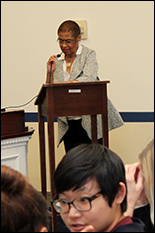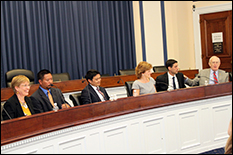UMD Center for Disaster Resilience Leads Hill Discussion on D.C. Flood Risk
The University of Maryland Center for Disaster Resilience (CDR) joined forces with Congresswoman Eleanor Holmes Norton (D-DC) to lead a Capitol Hill discussion on the risks flooding poses to D.C. and national security interests. The forum, which also featured speakers from local and federal agencies, addressed how climate change and urbanization could impact the frequency and severity of flooding in the nation's capital. CDR led the forum on Sept. 13 with support from the University of the District of Columbia, George Mason University, and the D.C. Silver Jackets, an interagency team comprising members from federal, District and regional agencies and academia who are working towards reducing flood risk and assisting local communities. “We entitled this briefing, Assessing Flood Risks in the District of Columbia and the National Capital Region; the reason that [the agencies and academia] work together across the region – is because water and floods don’t recognize boundaries,” Norton said. The Congresswoman discussed her new bill to amend the Coastal Zone Management Act of 1972 to include the District of Columbia in the definition section of a coastal state, and make D.C. eligible for federal coastal zone management funding. Norton chose the day of CDR’s flood forum to introduce the bill. The District of Columbia faces three types of flood risks, CDR Director and Department of Civil and Environmental Engineering (CEE) Senior Research Engineer Sandra Knight explained: riverine – caused by the convergence of the Potomac and Anacostia Rivers - tidal and coastal storm surge, and interior flooding, otherwise known as storm water flooding.
In fact, 30 percent of federal lands inside the District of Columbia are subject to flooding, Knight said. “When we think of floods, we always want to think of human safety first,” she said. “We have critical infrastructure, and various transportation networks - such as the airport, and critical government operations. If things get shut down in the District of Columbia and the NCR, things get shut down at the national level, and that can present national security issues.” Along with Norton’s and Knight’s presentations, the flood forum featured a five-member panel discussion, moderated by CEE’s Gerry Galloway, Glenn L. Martin Institute Professor of Engineering. This year's panelists were Nick Bonard (National Capital Planning Commission), Amy Guise (U.S. Army Corps of Engineers), Phetmano Phannavong (D.C. Department of Energy and Environment), Rick Sacbibit (Federal Emergency Management Agency [FEMA]), and Tanya Spano (Metropolitan Washington Council of Governments). “The District faces three types of flooding, but the National Flood Insurance Program does not address all three types of flooding,” Phannavong said. “Therefore, we have to discuss how to address, for instance, sewer backups, as they were not the intent of the program. And, we really need to talk to other stakeholders in the city – particularly the federal agencies as well as the private organizations – on how we can address flood risk in the city and have a more holistic approach, not just [an approach] based on the [National Flood Insurance] program or a mandate.” “A lot of the things you hear from FEMA as it relates to the NCR center on one thing: shared results,” Sacbibit said. “We’re all after the same thing, but how do we get on the same page? There are so many things in play here. There are multiple jurisdictions. There are multiple areas that are flooding. How do we identify these elements so that people have an appreciation of the flood hazard that’s present and the risk that is impacting various different stakeholders; and, how do we raise awareness of what’s happening, not just at the federal level but at the local level and even in our own homes?” Similarly, Galloway emphasized the importance of carrying lessons learned from past flood events and natural hazards into discussions of building resilience. One such example, he noted, is the North Atlantic Coast Comprehensive Study, spearheaded by the U.S. Army Corps of Engineers. “[In the wake of Superstorm Sandy], the study identified nine focus areas, one of which was D.C.” Guise explained. “We want to make sure the study is filling in gaps that D.C. needs met. [The study] is not here to replace all the good work that is already being done. Its purpose is to offer the best data and science available, and move what we have done – and what others have done – the next step forward.” Beyond the Army Corps’ study, the forum’s discussion leaders emphasized the importance of interagency cooperation in working to build flood resilience in D.C. and the surrounding areas.
“If you’re trying to be sustainable and if you’re trying to protect your interests and infrastructure, you need to think about all risks and who it will impact,” Spano said. “You have to think about flooding or a hurricane or a natural disaster and see the potential ripple effect such an event could have on an entire region. Our job is to raise the level of understanding that there are some risks that are local – and will stay local – but when we start to see the accumulation and exacerbation of flooding on a larger scale, then we’re all affected.” Driving home the fact that the flood risks impacting the D.C. region are eminent, Galloway emphasized the need for urgent action. “This is coming – and we know it’s coming – and we can’t simply say, ‘Well, we can fix it later,’” Galloway said. “You have to start planning – and you have to start securing funding – planning [without action] doesn’t get you very far. The challenges of the NCR are large – there are things we need to start thinking about and we need to actually move ahead on them. We can’t solve the problem [in a single day], but the universities in this area are certainly willing to partner with local organizations to work through this.” Additional event photos are available online.
Related Articles: September 19, 2016 Prev Next |



 “In the National Capital Region (NCR), we’re a part of the Potomac watershed, and we have a lot of upstream watershed that pours into our neighborhood,” Knight said. “We’re also well connected to the Chesapeake Bay, which becomes a major factor for us when we talk about tidal and coastal flood risk.
“In the National Capital Region (NCR), we’re a part of the Potomac watershed, and we have a lot of upstream watershed that pours into our neighborhood,” Knight said. “We’re also well connected to the Chesapeake Bay, which becomes a major factor for us when we talk about tidal and coastal flood risk.  “[The National Capital Planning Commission] is convening the major agencies and the District of Columbia so that we can talk about shared resources and shared strategies,” Bonard said. “It’s really important in this region because there’s so much federal land that anything the federal agencies do [to their land] will have a big impact on the city’s ability to protect from floods.”
“[The National Capital Planning Commission] is convening the major agencies and the District of Columbia so that we can talk about shared resources and shared strategies,” Bonard said. “It’s really important in this region because there’s so much federal land that anything the federal agencies do [to their land] will have a big impact on the city’s ability to protect from floods.”